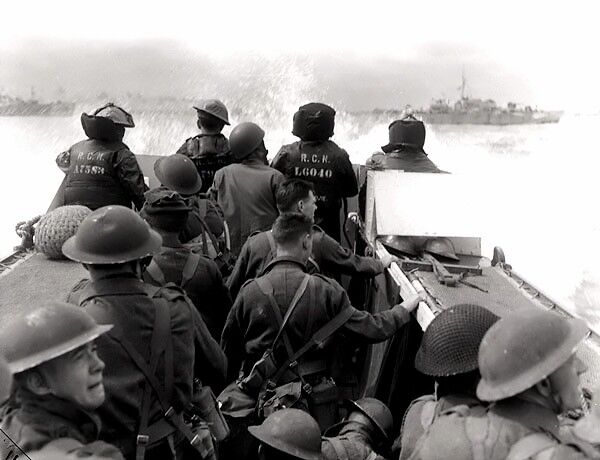The following article on the Canadian Army in World War 2 (Canadian Army WW2) is an excerpt from Barrett Tillman’ D-Day Encyclopedia. It is available for order now from Amazon and Barnes & Noble.
Too few people respect Canada’s enormous contribution to D-Day. Canadians fought as part of the British Commonwealth, as they were a satellite nation of theirs at the time; therefore, they were equipped with the same weapons as the British Army. But being quasi-independent and across an ocean meant they also drew on American experience and equipment.
During World War II Canada absorbed more than one million personnel for the armed forces, including 766,491 men and 25,252 women for the army. However, Canada’s commitment to the European war was seldom taken for granted. The government of W. L. M. King, elected in 1935, was reluctant to send large numbers of troops to a repetition of the Great War, which had resulted in forty-two thousand killed and fifty-three thousand wounded from a total of 1,086,000 in uniform. Nevertheless, Ottawa approved mobilization on the day Germany invaded Poland, and Canada declared war on the 10th. The Empire training scheme was expanded, and existing troops were deployed to Britain in response to requests from London.
Subsequently, in early 1940 King was reelected on the basis of no conscription for overseas service. The National Resources Mobilisation Act prohibited conscripts from being sent overseas, but eventually the demand overcame Canadian reluctance. By the following year planners had drafted preparations for fielding two corps totaling four infantry and two armored divisions, plus support troops. By war’s end the First Canadian Army was composed of six infantry and four armored divisions plus two tank and two artillery brigades, while other formations served in non-Canadian commands.
After the Japanese attack on Hawaii in December 1941, the national mood largely changed. Recognizing the potential threat to its Pacific coast, the King government sought a referendum permitting drafting of military personnel for service abroad. In April 1942 the English-speaking sector of the electorate handily approved the measure; the province of Quebec rejected it by nearly 75 percent. Though the English majority held sway, actual conscription for deployment was not acted upon until late 1944.
The Canadian Second Division had nearly been destroyed in the Dieppe landing of August 1942, and that incident loomed large in the consciousness of Canadian and British leaders alike. At a time when Britain itself was strapped for manpower, reliance upon the Dominion was probably unavoidable. Nevertheless, many Canadians bitterly resented the appearance that the ‘‘Brits’’ were again sending ‘‘the colonials’’ on high-risk assignments. One factor often overlooked, however, was that the Canadians were trained for amphibious operations, while many British divisions were not.
At the end of 1943 the Canadian army had some 250,000 men overseas, including a major segment in Italy. The Canadians had also been engaged in the seizure of Sicily that summer. By June 1944 the army numbered 417,800 General Service personnel plus 65,800 drafted under the National Resources Mobilisation Act—men retained for service at home.
Throughout the European war, some eleven thousand Canadian troops lost their lives. Overall army losses totaled 22,900 killed or dead from all causes, including about five thousand noncombat deaths. Two Canadian army divisions participated on D-Day:
Third Infantry Division
The most successful Allied unit on D-Day, the Third Canadian Infantry Division landed on Juno Beach under Maj. Gen. R. F. L. Keller. He was succeeded by Maj. Gen. D. C. Spry on 8 August.
Comprising three brigades, the division was generally organized along the British model but with some regional differences.
• Seventh Infantry Brigade: Brig. H. W. Foster.
• Eighth Infantry Brigade: Brig. K. G. Blackader.
• Ninth Infantry Brigade: Brig. D. G. Cunningham.
The fifteen thousand Canadian troops who landed on D-Day represented about 20 percent of the total Allied force. They sustained 359 killed and 715 wounded on 6 June, from a total 5,400 killed in the Normandy campaign.
Second Armoured Brigade
Operating with the Third Infantry Division, the tank component of the Juno assault force numbered some 3,500 men. The main elements were the Sixth, Tenth, and Twenty-seventh Armoured Regiments, operating American-built Sherman tanks. Each four-tank troop included an ‘‘upgunned’’ Firefly with a seventeen-pounder gun, a 76 mm weapon more effective against German armor than was the standard 75 mm gun.
This article on the Canadian Army in World War Two (Canadian Army WW2) is from the book D-Day Encyclopedia, © 2014 by Barrett Tillman. Please use this data for any reference citations. To order this book, please visit its online sales page at Amazon or Barnes & Noble.
You can also buy the book by clicking on the buttons to the left.
This article is part of our larger resource on the WW2 Armies warfare. Click here for our comprehensive article on the WW2 Armies.
Additional Resources About WW2 Armies
Cite This Article
"Canadian Army in WW2" History on the Net© 2000-2024, Salem Media.
April 18, 2024 <https://www.historyonthenet.com/canadian-army-ww2>
More Citation Information.
